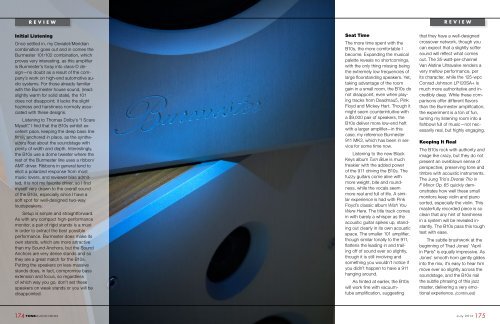Create successful ePaper yourself
Turn your PDF publications into a flip-book with our unique Google optimized e-Paper software.
REVIEW<br />
REVIEW<br />
Initial Listening<br />
Once settled in, my Devialet/Meridian<br />
combination goes out and in comes the<br />
Burmester 101/102 combination, which<br />
proves very interesting, as this amplifier<br />
is Burmester’s foray into class-D design—no<br />
doubt as a result of the company’s<br />
work on high-end automotive audio<br />
systems. For those already familiar<br />
with the Burmester house sound, (read:<br />
slightly warm for solid state), the 101<br />
does not disappoint; it lacks the slight<br />
haziness and harshness normally associated<br />
with these designs.<br />
Listening to Thomas Dolby’s “I Scare<br />
Myself,” I find that the B10s exhibit excellent<br />
pace, keeping the deep bass line<br />
firmly anchored in place, as the synthesizers<br />
float about the soundstage with<br />
plenty of width and depth. Interestingly,<br />
the B10s use a dome tweeter where the<br />
rest of the Burmester line uses a ribbon/<br />
AMT driver. Ribbons in general tend to<br />
elicit a polarized response from most<br />
music lovers, and reviewer bias admitted,<br />
it is not my favorite driver, so I find<br />
myself very drawn to the overall sound<br />
of the B10s, especially since I have a<br />
soft spot for well-designed two-way<br />
loudspeakers.<br />
Setup is simple and straightforward.<br />
As with any compact high-performance<br />
monitor, a pair of rigid stands is a must<br />
in order to extract the best possible<br />
performance. Burmester does make its<br />
own stands, which are more attractive<br />
than my Sound Anchors, but the Sound<br />
Anchors are very dense stands and so<br />
they are a great match for the B10s.<br />
Putting the speakers on less-massive<br />
stands does, in fact, compromise bass<br />
extension and focus, so regardless<br />
of which way you go, don’t set these<br />
speakers on weak stands or you will be<br />
disappointed.<br />
Seat Time<br />
The more time spent with the<br />
B10s, the more comfortable I<br />
become. Expanding the musical<br />
palette reveals no shortcomings,<br />
with the only thing missing being<br />
the extremely low frequencies of<br />
large floorstanding speakers. Yet,<br />
taking advantage of the room<br />
gain in a small room, the B10s do<br />
not disappoint, even when playing<br />
tracks from Deadmau5, Pink<br />
Floyd and Mickey Hart. Though it<br />
might seem counterintuitive with<br />
a $9,000 pair of speakers, the<br />
B10s deliver more low-end heft<br />
with a larger amplifier—in this<br />
case, my reference Burmester<br />
911 MK3, which has been in service<br />
for some time now.<br />
Listening to the new Black<br />
Keys album Turn Blue is much<br />
freakier with the added power<br />
of the 911 driving the B10s. The<br />
fuzzy guitars come alive with<br />
more weight, bite and roundness,<br />
while the vocals seem<br />
more real and full of life. A similar<br />
experience is had with Pink<br />
Floyd’s classic album Wish You<br />
Were Here. The title track comes<br />
in with barely a whisper as the<br />
acoustic guitar spikes up, standing<br />
out clearly in its own acoustic<br />
space. The smaller 101 amplifier,<br />
though similar tonally to the 911,<br />
flattens the leading in and trailing<br />
off of sound ever so slightly,<br />
though it is still involving and<br />
something you wouldn’t notice if<br />
you didn’t happen to have a 911<br />
hanging around.<br />
As hinted at earlier, the B10s<br />
will work fine with vacuumtube<br />
amplification, suggesting<br />
that they have a well-designed<br />
crossover network, though you<br />
can expect that a slightly softer<br />
sound will reflect what comes<br />
out. The 35-watt-per-channel<br />
Van Alstine Ultravalve renders a<br />
very mellow performance, per<br />
its character, while the 125-wpc<br />
Conrad Johnson LP120SA+ is<br />
much more authoritative and incredibly<br />
deep. While these comparisons<br />
offer different flavors<br />
than the Burmester amplification,<br />
the experiment is a ton of fun,<br />
turning my listening room into a<br />
fishbowl full of music—not necessarily<br />
real, but highly engaging.<br />
Keeping It Real<br />
The B10s rock with authority and<br />
image like crazy, but they do not<br />
present an overblown sense of<br />
perspective, preserving tone and<br />
timbre with acoustic instruments.<br />
The Jung Trio’s Dvorak Trio in<br />
F Minor Op. 65 quickly demonstrates<br />
how well these small<br />
monitors keep violin and piano<br />
sorted, especially the violin. This<br />
masterfully recorded piece is so<br />
clean that any hint of harshness<br />
in a system will be revealed instantly.<br />
The B10s pass this tough<br />
test with ease.<br />
The subtle brushwork at the<br />
beginning of Thad Jones’ “April<br />
in Paris” is equally impressive. As<br />
Jones’ smooth horn gently glides<br />
into the mix, it’s easy to hear him<br />
move ever so slightly across the<br />
soundstage, and the B10s nail<br />
the subtle phrasing of this jazz<br />
master, delivering a very emotional<br />
experience. (continued)<br />
174 TONE AUDIO NO.64<br />
174<br />
July 2014 175




